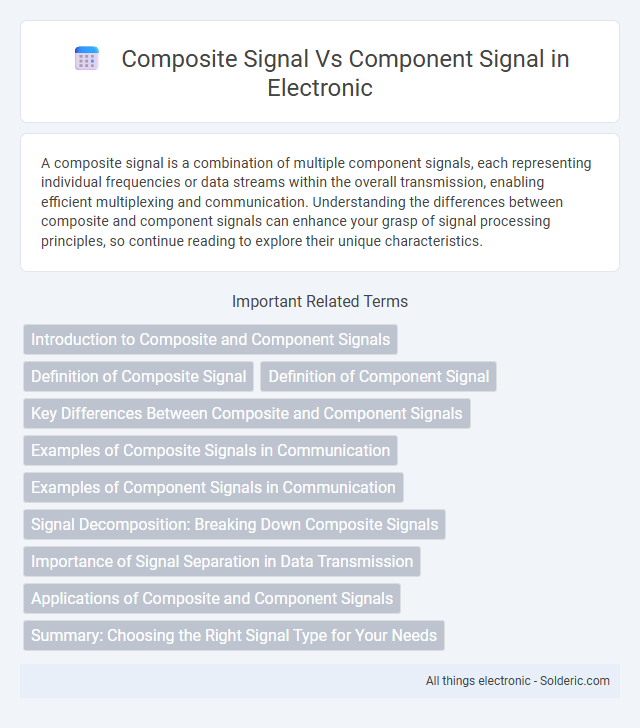A composite signal is a combination of multiple component signals, each representing individual frequencies or data streams within the overall transmission, enabling efficient multiplexing and communication. Understanding the differences between composite and component signals can enhance your grasp of signal processing principles, so continue reading to explore their unique characteristics.
Comparison Table
| Feature | Composite Signal | Component Signal |
|---|---|---|
| Definition | Combination of two or more individual signals | Individual or basic signal element |
| Complexity | High, due to multiple combined elements | Low, represents a single signal type |
| Frequency Content | Contains multiple frequency components | Single frequency or narrow frequency band |
| Analysis | Requires decomposition techniques (e.g., Fourier analysis) | Directly analyzed and interpreted |
| Applications | Communication systems, signal processing, multiplexing | Basic waveform generation, modulation basis |
| Example | Composite audio signal with multiple instruments combined | Single tone or sinusoidal wave |
Introduction to Composite and Component Signals
Composite signals consist of multiple component signals combined into one waveform, representing complex real-world phenomena like speech or music. Each component signal contributes distinct frequency, amplitude, or phase characteristics, which can be individually analyzed through techniques such as Fourier transform. Understanding the relationship between composite and component signals is essential for signal processing applications including noise reduction, modulation, and data compression.
Definition of Composite Signal
A composite signal is a combination of two or more component signals that are superimposed to form a complex waveform containing multiple frequency components. Each component signal contributes distinct amplitude, frequency, and phase characteristics, which when summed, create a composite signal used in communications and signal processing. Understanding the spectral content of composite signals is essential for applications like modulation, multiplexing, and noise analysis.
Definition of Component Signal
A component signal is an individual waveform or frequency element that combines with others to form a composite signal. Each component signal carries specific information or characteristics and can be isolated through signal processing techniques like Fourier analysis. Understanding your component signals allows for precise manipulation and analysis of complex composite signals in various communication and engineering applications.
Key Differences Between Composite and Component Signals
Composite signals combine multiple individual component signals into a single transmission or waveform, whereas component signals are the distinct, separate parts that make up a composite signal. Composite signals often carry more complex information by integrating audio, video, or data streams, while component signals maintain their individual properties and can be processed independently. Understanding the distinction helps optimize signal processing, transmission quality, and system design in telecommunications and multimedia applications.
Examples of Composite Signals in Communication
Composite signals in communication often consist of multiple frequency components combined to represent complex information, such as in amplitude modulation (AM) and frequency modulation (FM) used in radio broadcasting. Examples include television signals, which integrate video, audio, and synchronization data into a single composite waveform, and digital communication systems where composite signals carry multiplexed data streams over a shared channel. These signals enable efficient transmission of multi-dimensional information by encoding various components into one unified signal form.
Examples of Component Signals in Communication
Component signals in communication include baseband signals, carrier waves, and modulated waveforms such as amplitude modulation (AM) and frequency modulation (FM) components. Each component signal carries specific information, like voice frequencies in telephony or digital bits in data transmission, which combine to form a composite signal for efficient communication. Your understanding of component signals helps in analyzing how complex signals are constructed and processed for transmission and reception.
Signal Decomposition: Breaking Down Composite Signals
Composite signals consist of multiple component signals combined into a single waveform, making analysis complex without proper decomposition. Signal decomposition techniques, such as Fourier Transform and wavelet analysis, enable you to break down composite signals into their individual component frequencies or time-frequency elements. This process is essential for applications in communications, audio processing, and biomedical engineering, where isolating component signals reveals underlying information and enhances signal interpretation.
Importance of Signal Separation in Data Transmission
Signal separation plays a crucial role in data transmission by isolating component signals from a composite signal, ensuring accurate decoding and minimizing interference. Efficient extraction of individual signal components enhances clarity and reliability, directly impacting the quality of communication systems. Mastering this process helps you maintain optimal data integrity and reduces errors in complex transmission environments.
Applications of Composite and Component Signals
Composite signals enable efficient transmission in telecommunications by combining multiple component signals into one aggregated waveform, essential for multiplexing in fiber optics and radio broadcasting. Component signals are crucial in signal processing and analysis, allowing extraction and manipulation of individual frequency components for applications like audio equalization and medical imaging diagnostics. These distinctions support advancements in wireless communication, radar systems, and digital signal processing, enhancing data integrity and transmission efficiency.
Summary: Choosing the Right Signal Type for Your Needs
Composite signals combine multiple component signals into one waveform, enabling efficient transmission and processing of complex data. Component signals represent individual, distinct waveforms that are easier to analyze and modify independently but may require more bandwidth. Your choice depends on whether you prioritize integrated data handling with composite signals or precise control and clarity with component signals.
composite signal vs component signal Infographic

 solderic.com
solderic.com